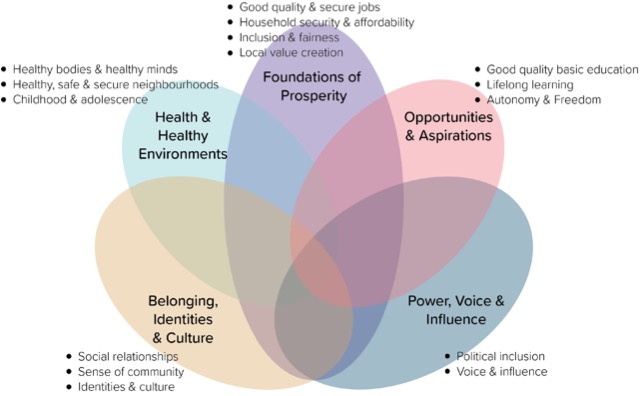I have lived, worked and served the community in east London for over 40 years. Parts of east London, for instance around the Queen Elizabeth Olympic Park (in Newham, Waltham Forest, Tower Hamlets and Hackney,) the Film Quarter (in Barking and Dagenham) and along the Crossrail route (in Redbridge and Havering), are undergoing profound and rapid change. There is a long history of photographic exploration of east London. In this project, I seek to build on, and go beyond, this work by working collaboratively with the agencies and community groups that comprise the London Prosperity Board (LPB), of which I have recently become a member. The approach developed by the LPB identifies five areas of activity that underpin the ability of local communities to flourish and prosper.

London Prosperity Board, 2017: 3
My proposed project:
- focuses on small areas. The LRB focuses on census output areas, which comprise of around 100 households. This enables in-depth engagement with and understanding of communities and their contexts. The LRB has carried out preliminary research in five east London areas.
- is multi-professional and inter-disciplinary. The work involves collaboration with a wide range of community groups, professionals and disciplines (including social anthropologists working with local communities on education, health and employment issues, and engineers working with citizen scientists on the collection of data, for instance on local air quality). This enables exploration of how photography relates to, and can be enriched by, other forms of practice and ways of understanding. It also entails consideration of the relationship between arts-based approaches to research and physical and social science research. In carrying out this work, I intend to keep in mind Barthes contention that ‘in order to do interdisciplinary work it is not enough to take a “subject” (a theme) and to arrange two or three sciences around it. Interdisciplinary study consists in creating a new object, which belongs to no one’ (1986:73).
- is multi-modal (Kress, 2009). Diverse forms of data are being collected, which are being analysed and presented in a variety of different modes (maps, visualisations, photographic images, sound, video and so on). The final form of presentation of my work with involve consideration of the relationship between photographic images and other modes of presentation.
- entails a multiplicity of forms of photographic image making.

Bromley-by-Bow, 2018
The project will give rise to three distinct forms of photographic images, engaging different audiences and entailing a range of means of dissemination.
- individual residents will produce images as part of a Photovoice style research programme. Photovoice is an approach to participatory research initially proposed by Wang and Burris (1997), and widely used as an approach in research that explores the life-worlds of individuals and communities. Community members are provided with cameras and instruction to make images of their everyday lives. These images provide both insight for researchers and participants and act as the basis for collaborative meaning making and discussion. It is both educative and empowering as a process, making visible both opportunities and constraints, and providing individuals and communities with the critical resources to shape their futures. Participants will retain ownership of the images produced, to be used strictly with permission in any presentation of the outcomes of this aspect of the project.
- images produced collaboratively for use by the LRB and local community groups, for which, I anticipate, authorship will be jointly attributed and the images distributed under an appropriate creative commons license (most likely CC BY-NC). My experience in working with policy makers as an academic researcher, is that whilst rigorous research is a pre-requisite, often policy makers are also influenced by narratives, and utilize these narratives in the development and implementation of policy. In this component of the project I want to explore the use of images in the development of these research-related narratives, alongside other images such as info-graphics and visual representations of data.
- my own images, produced as a response to the work carried out with the LRB and residents. My involvement with and commitment to the east London has both emotional and intellectual dimensions. Inspired by the manner in which Christian Thompson, an Australian Aboriginal artist, has created images in response to artifacts and photographs, I want to produce work that responds to images produced in the course of the project, and my own engagement with the areas and their communities. This will entail experimentation with a range of forms of image making over the coming year, and exploration of the potential and limitations of my own practice to date.

Bromley-by-Bow, 2018
The artistic outcomes of the project will combine these different levels of image making. The project will provide opportunities for public exhibitions (through UCL galleries and events, and links with east London community groups), and publication (in print and online). In exhibition form, the complexity of the inter-relationship between the forms of work produced will demand something akin to the multi-modal form of Edmund Clark’s ‘In Place of Hate‘ (2015-7). In print form, it would be interesting to explore incorporation of other media, for instance in the way that Lewis Bush (2018) has used barcodes to incorporate sound into his book ‘Shadows of the State’. I also hope to explore the benefits of incorporation of an arts based approach to research with physical and social science research.
References
Barthes, R. (1986). The Rustle of Language (trans. R. Howard). Oxford: Basil Blackwell.
Bush, L. (2018). Shadows of the State. London: Brave Books.
Kress, G. (2009). Multimodality: A social semiotic approach to contemporary communication. London: Routledge.
Wang, C. & Burris, M. A. (1997). Photovoice: Concept, Methodology, and Use for Participatory Needs Assessment. Health Education & Behavior, 24(3), 369–387.
Websites
Edmund Clark, 2015-17, In Place of Hate. https://www.edmundclark.com/works/in-place-of-hate/#1 (accessed 15.10.18).
Creative Commons, https://creativecommons.org/licenses/ (accessed 15.10.18).
Photovoice. https://photovoice.org/ (accessed 15.10.18).
Christian Thompson, 2018, Ritual Intimacy. https://artguide.com.au/christian-thompson-ritual-intimacy (accessed 15.10.18).
